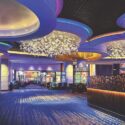
Building green has its benefits.
For the owners of the new Graton Resort & Casino in Rohnert Park, California, those include the anticipated receipt of a nearly $165,000 incentive award from Pacific Gas and Electric Company (PG&E). The design team, including Las Vegas-based KGA Architecture, Farmington Hills; Michigan-based lighting designer Illuminating Concepts; and JBA Engineering Consultants, shared an additional $50,000 award.
To secure the incentives, JBA Trusted Advisors helped design a building that would exceed the requirements of the California Green Building Standards Code, Title 24, by 15.6 percent. The awards are paid under a state-mandated program called “Savings by Design.”
“Of course, the real savings come from the enhanced efficiency of the building,” says Ryan Marruffo, senior account manager for PG&E. “By designing the casino with energy efficiency top of mind, the owners will save more than one million kilowatts of energy.” At current rates, that’s about $139,000 per year.
Graton Resort and Casino
The $800 million Graton Resort & Casino, which opened November 5, is located north of San Francisco. The facility offers 144 table games, including a poker room and 3,000 slot and video poker machines. There are four stand-alone restaurants, three bars, a 500-seat Marketplace dining area featuring an additional nine casual restaurants, and a 750-seat event center. Owned by the Federated Indians of Graton Rancheria, the resort is managed by Station Casinos of Las Vegas, who also handled the construction process. “We’ve worked on other Station properties, and they have the highest standards,” says JJ Wisdom, senior project manager, electrical engineering for JBA. “This is a really beautiful facility. It’s the only casino I’ve ever visited with a skylight (located inside the Sky bar).”
The property is unique in other ways as well. “Some casinos will provide backup power only for critical systems,” says Wisdom. “But with Station, there is never any question about backing up the slots and even the air handlers, so that, in the event of a power failure, play can go on with a reasonable level of comfort.”
Wisdom specified a closed transition paralleling switchgear electrical system with two 1.5KW generators, which will take over upon loss of utility power. It also allows for code-required generator testing to occur without interruption of casino functions. The design highlights the JBA philosophy that the comfort and enjoyment of the guests should not be compromised by the needs of an energy-efficient design. The mark of a great building system is that it delivers high functionality as well as efficiency.
There were three areas the design team focused on to reduce the building’s energy consumption:
1. The building envelope. “We worked hand-in-hand with Lee Norsworthy at KGA to make sure the walls, windows and roofing material met our insulation targets,” Wisdom says.
2. The HVAC system. Brian Patalon, senior mechanical engineer for JBA, explains that he was careful to specify highly efficient chillers and boilers to be controlled by the building management system (BMS). Beyond that, “our casino air handling units all contain energy recovery, so that we can bring in 100 percent outside air but not take a big hit on efficiency,” says Patalon. “The system passes incoming and outgoing air through a large, rotating honeycombed wheel, allowing cold winter air to be preheated by the warmer exhaust, and hot outside summer air to be precooled by the cooler exhaust.”
3. The lighting system. Wisdom explains that the team’s lighting strategy was simple: keep the total wattage down without reducing targeted levels. “In the back-of-house areas, we were able to stay 15 percent below Title 24 using fluorescent and compact fluorescent lighting, but in the front of house, where levels would be higher, we used all LED.”
The team also tied the lighting controls into the BMS to allow facility managers the ability to save even more. “In many cases,” Wisdom explains, “the specified lighting level is more than is really needed, and, since this is a 24-hour facility, there will be certain areas that are not used all the time.”
The Application Process
In order to document the savings, PG&E requires the creation of a computer energy model that provides detailed information about the energy used by the building’s systems.
“You enter a complete set of parameters, including type and number of light fixtures, boilers, chillers, and the software running a full-year simulation,” Patalon explains. “It outputs two numbers, one for your building and one for a hypothetical baseline building which equals the minimum requirements listed in Title 24. The difference determines the incentives you earn.”
The JBA team created an especially detailed model that output about 1,000 pages of information about individual systems, allowing the engineering team to fine-tune its designs. When the plans were finalized, Wisdom submitted the report to PG&E, together with a summary worksheet. The utility in turn approved the application, and then, once the construction process was complete, sent an auditing team to verify that the systems were installed as specified.
Wisdom says the application and audit was exacting, but “Ryan Marruffo was extremely helpful and knowledgeable. He made a huge difference in our ability to successfully navigate the process.”
Marruffo says the efforts went extremely well. “It was a pleasure to work with JJ and the others from JBA. They assembled an incredible amount of documentation and made sure it was correct.”

















